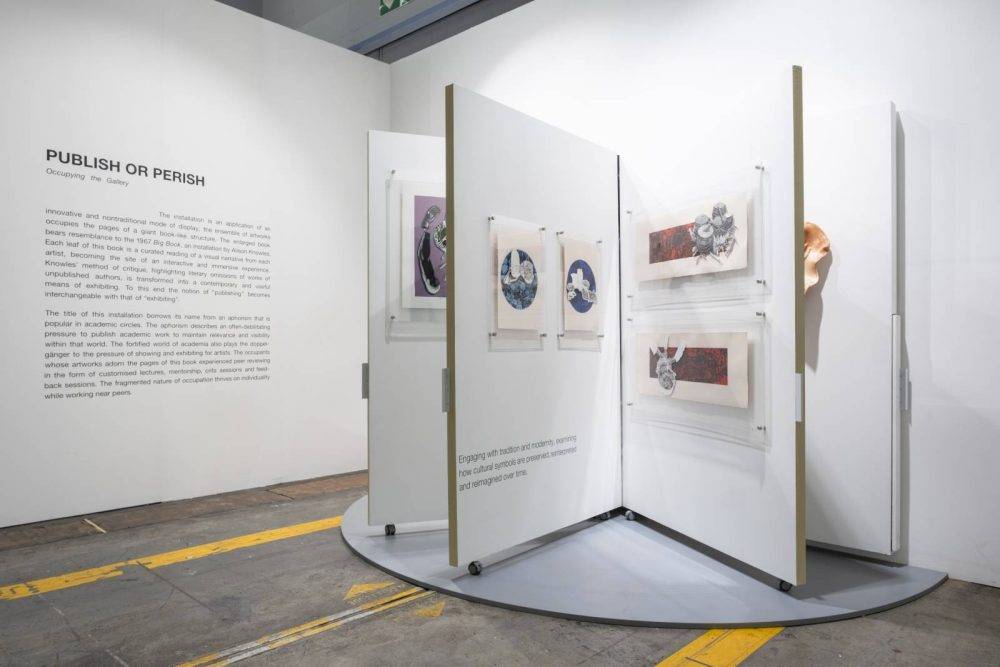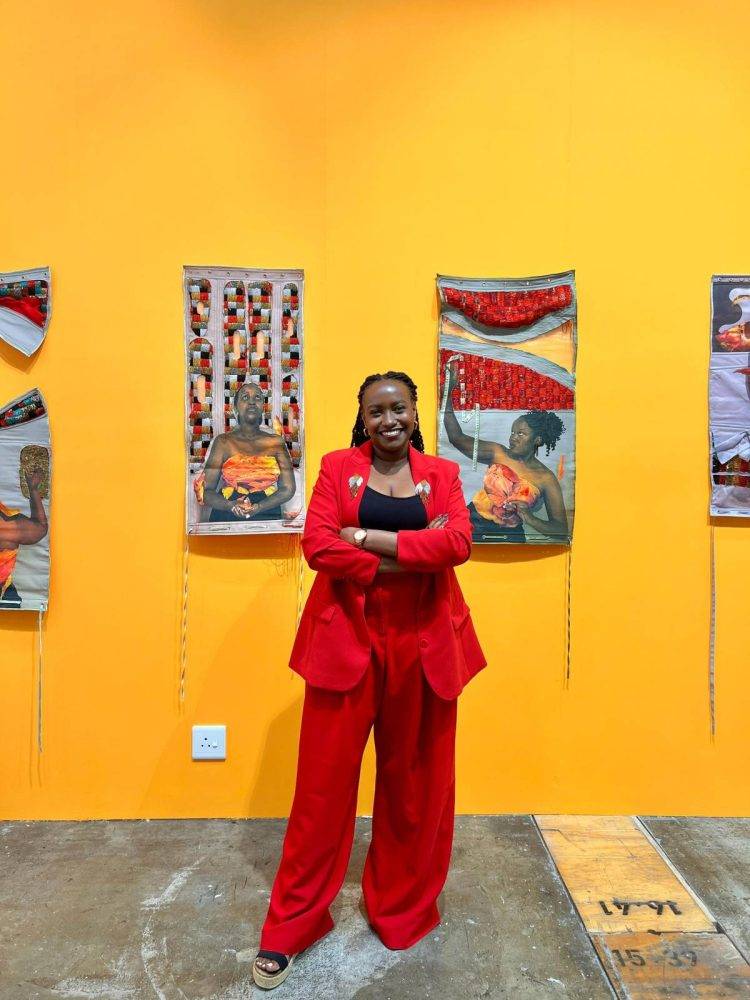ArtHarare’s campaign posters designed by artists,
I attended the 12th edition of the Investec Cape Town Art Fair last weekend. It was an incredible but overwhelming experience. With 124 exhibitors and more than 500 artists from 58 countries, it’s impossible to narrow down the work to a series of highlights. But I decided to give it a try anyway.
The exhibitions that stood out for me the most were the ones that creatively challenged the traditional white-cube structure of the typical art gallery and offered something new and different.
This year’s fair theme was Play, which challenged artists and gallerists to explore the role of playfulness in the curatorial and artistic process.
The three collections below struck me as great examples of how approaching creative work with a sense of playfulness can lead to original concepts, either in how the work is created or how it’s presented to the public. I especially like the idea of artistic concepts that encourage viewers to interact with the art in some tangible form.
As the fair’s director Laura Vincenti says: “Play has so many layers. It’s an act of creation, curiosity and engagement. It’s how children explore the world, how artists experiment and how new ideas emerge. We wanted to invite curators and artists to embrace the joy of discovery and informal experimentation.”
These three projects represent some of that joy of discovery and informal experimentation that embodies the essence of play.
 Occupying the Gallery’s Publish or Perish.
Occupying the Gallery’s Publish or Perish.
Threads of beauty, laced with meaning
One of the works at the fair that kept pulling me back was by Ugandan artist Charlene Komuntale, who uses corsets and digital painting to interrogate beauty standards.
“My work is about unravelling the threads of beauty,” she says. “And I use corsets as an entry point for conversation because of the running narratives around them. The corset is a garment, a historical one, that restricted women’s bodies, moulding them, and dictating what they should look like.
“But other historians also argue that women wore them at a time when they were unseen. And so, by exaggerating their bodies through fashion and the corset, they took up space. So my work sits in that duality, in that tension of what governs your understanding of beauty.”
In Komuntale’s work, black women are depicted in the intimate act of unfastening corsets — a confronting metaphor for unravelling the ideals and narratives long imposed on their bodies. As the strings are tugged and the garments give way, hidden layers emerge, each adorned with delicate beadwork and embroidery, revealing intricate stories beneath the surface.
“I want people who engage with the work to walk away with more questions than answers because I want every viewer to ask themselves what governs their understanding of beauty,” Komuntale says.
“I think introspective work is necessary for us to move forward. As women, we need to question what has framed our femininity. What has framed our thinking of worth?
“Honestly, if beauty is a tool of power, then why is it a tool of power? Who is it that decides who gets to be considered beautiful and who gets overlooked? Women are the custodians of culture and we need to ask ourselves, ‘How then are we going to inform that culture?’”
A page-turning exhibition
One booth at the fair that stopped me in my tracks was Publish or Perish by Occupying the Gallery which replaced the white-cube structure with a giant book concept, complete with wheels to turn the pages, each featuring a different artist.
“The Big Book is like a bigger kind of concept of not only being able to exhibit or publish, but also the notion of publishing being interchangeable with the process of exhibiting,” says Lawrence Lemaoana who established Occupying The Gallery, along with his wife and fellow artist Mary Sibande, to nurture emerging artists.
The young artists who participated in the exhibition were Lungile Ngcobo, Mosa Anita Kaiser, Sphatho Mzantsi and Puseletso Masemene.
“For us, it’s like playing these kinds of games. But the idea, again, is because we’re in an art fair, our entry needs to be appropriate.
“And so the interactivity of this book becomes also functional for us, and it becomes an experience for the audience, and not just a vehicle for selling objects,” Lemaoana adds.
The installation takes a fresh, unconventional approach to display, evoking a giant book brought to life, with artworks filling its pages. This echoes Big Book, a 1967 installation by American artist Alison Knowles, but with a modern twist.
Each page becomes a curated visual story, offering an immersive and interactive experience for viewers. Knowles’ original critique of literary omissions, giving space to unpublished authors, is reimagined here as a bold exhibition format. In this case, “publishing” and “exhibiting” become one and the same.
The title of the installation borrows from a well-known academic saying, referring to the relentless pressure to publish in order to stay relevant. That pressure mirrors the world of art, where visibility often depends on consistently showing work.
The artists featured in this installation went through their own kind of peer review, through lectures, mentorship, critiques, and feedback sessions. While each artist’s work stands on its own, there’s a dynamic push-and-pull of individuality and collective experience.
 Charlene Komuntale at the Cape Town Art Fair.
Charlene Komuntale at the Cape Town Art Fair.
Power to the paintbrush
ArtHarare challenged artists to create campaign posters for reimagined political parties run by artists themselves. The exhibition was interactive, containing a booth and ballot box where people could cast their vote for the artists’ political party they wanted to see in power.
“The concept of the artist general election was inspired by the past 24 months, from 2023 to 2024, where in the world there were over 100 elections,” says Richard Mudariki, founder and director of ArtHarare.
“So, people went to the polls to vote for leaders and for artists. As we walked through streets during the campaigns here in South Africa and in Zimbabwe, there were political posters that were placed over buildings and on street polls.
“And for us, working with artists who are interested in interrogating politics, power, society and democracy, this was a concept that excited us. The exhibition poses the question: ‘What would the world look like if artists were given positions of power and influence?’”
The 2025 Artists General Election brought together a powerhouse lineup of creatives from across the globe, including South Africans Nelson Makamo, Siwa Mgoboza, Nandipha Mntambo, Farai Samurai, Thania Peterson and Blessing Ngobeni. They were joined by artists from Canada, Botswana, Nigeria, Uganda, Zimbabwe, the UK, and the US, all rallying behind a bold, imaginative take on democracy.
In this reimagined election, the usual political parties were swapped out for artist-led movements like Artists National Congress (ANC), Democratic Artist (DA), Creative Freedom Fighters (CFF), Umbrella Democratic Curators (UDC), Creative Coalition for Change (CCC), Zimbabwean Artists National Union (Zanu), Make Art Great 2025 and New Deal for the Working Artist (UK).
More than just an exhibition, the 2025 Artists General Election was a statement — an invitation to see art as a tool for change, a way to shape public consciousness, and a space where creative voices take the lead.
Here, voting wasn’t just about ballots, but about ideas, expression and the power of imagination.